Yes snakes do eat cats.
While cats aren’t natural prey for snakes, snakes are opportunists who will eat small mammals.
All cats hunt, whether they are feral or household pets and snakes share the same alimentary niche, so the likelihood of conflicts between snakes and cats are high.
Of course, this depends on different conditions, such as where you live and the kind of snakes that inhabit your area.
The size of the snake will determine what kind of victims it will stalk.
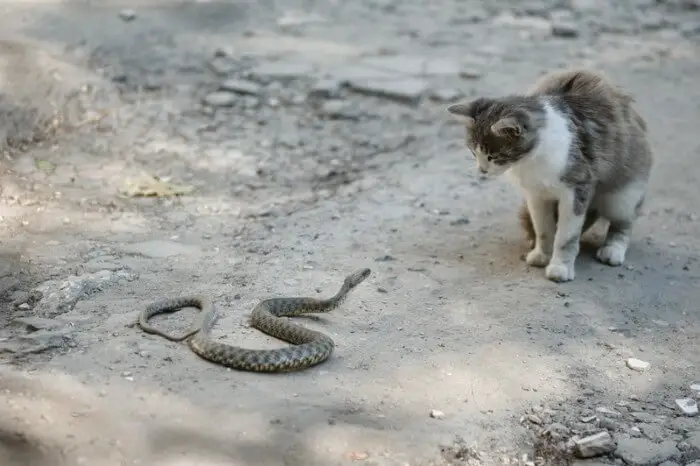
Contents
What To Do To Keep Your Cat Safe From Snakes:
- Keep lawns short
- Put all trash in containers
- Clear away any likely hiding or nesting places
- Install snake-proof fencing around your property
- Keep cats inside a protected area
- Don’t leave cat or other pet food outside
- Use snake repellent in your garden (amazon link)
- Snakes also don’t like vinegar (amazon link), so splash some of it around
- As snakes can smell humans and usually shy away from them, sprinkle some human hair around your property
- Place ammonia (amazon link) saturated cloths in likely spots
– Lifespan: snakes can live up to 40 years
– Length: anything from a few inches to several yards
– Diet: carnivorous
– Habitat: all over the world except Antarctica, Iceland, Ireland, and New Zealand
Statistics about Snakes
There are 21 recorded species of venomous snakes in North America, but not all are deadly. They are distributed all around the union, with the exception of Alaska.
Only 70% of snakes actually reproduce by laying eggs. The other 30% give birth to live offspring like other mammals.
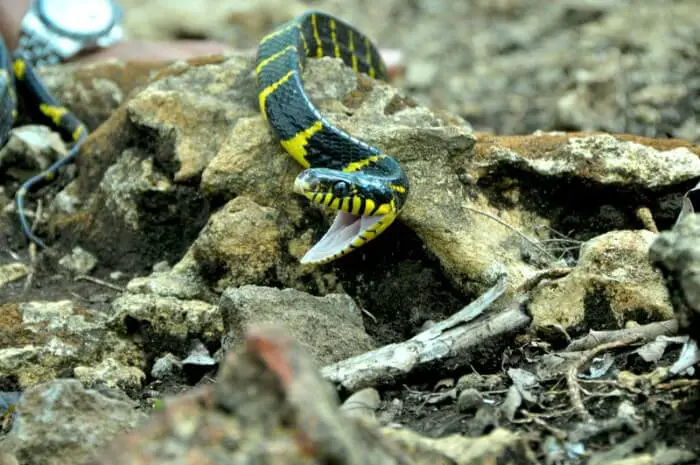
Most snakes will attack prey that is 75%- 100% larger than themselves.
Snakes are at their most active between the months of March and October.
The Anecdotal Evidence For Snake Attacks On Cats
If you ask do snakes eat cats you will find that the evidence is sketchy. Although you can find videos of snakes attacking cats on the internet, but there isn’t a large body of evidence to support the theory that they do with any great frequency. That doesn’t mean to say that it doesn’t happen.
Cats are as likely to be attacked and eaten by snakes as any other household pet. In fact, they may be in greater danger because of their natural behaviour.
Cats are by nature carnivores and hunters. They like to explore and are curious creatures. They also hunt the same kind of creatures as snakes do.
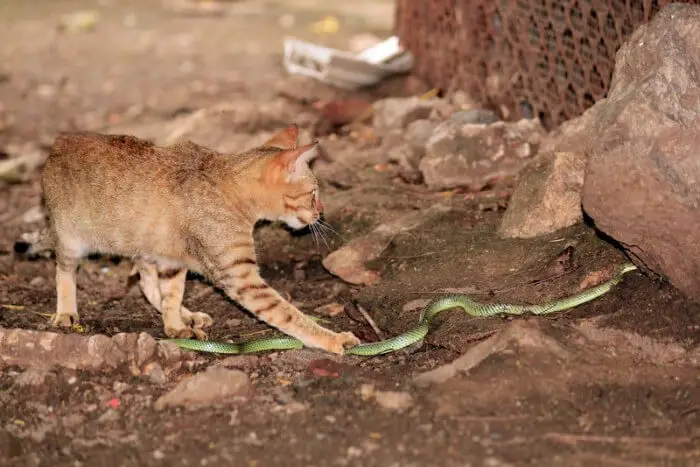
Chance encounters are bound to happen, especially if your cat is allowed to roam free. Most conflicts between species are usually determined by size. A small cat (such as Mr. Peebles or a kitten)may seem a tempting prey to a large snake. Some attacks will be in self-defence.
Other attacks may be caused by hunger and opportunity. Those cat owners that live in a rural setting or in communities that are on the edge of wildlife zones will need to worry more than those that live urban areas.
Some snakes are venomous and some are poisonous. The difference between the two kinds is that venomous snakes deliver their toxic venom by biting and puncturing their prey with their fangs and are considered the more aggressive kind of snake, whereas the poisonous ones are more passive and pass on their toxins through ingesting.
Not all venomous snakes have deadly venom. Many venoms are only toxic enough to paralyze the snake’s prey. Boas and Pythons crush and suffocate their victims by constriction.
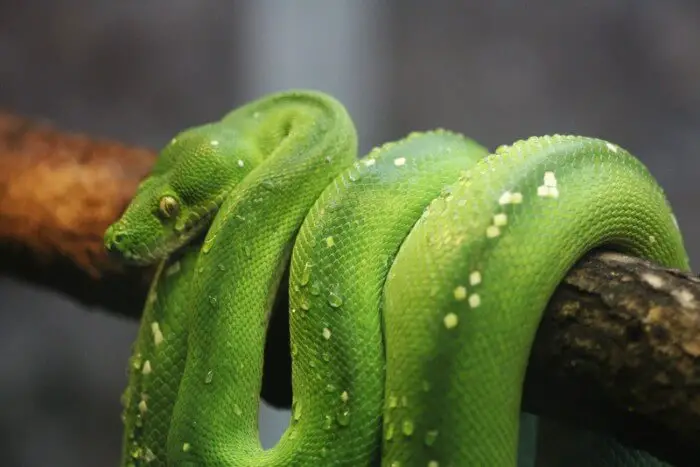
From the 1980s, the Florida Everglades has been the host to an invasion of Burmese Pythons which has ravaged the mammal population and unbalanced the local ecosystem.
These snakes that can grow up to 20 feet long were brought to America as exotics pets but escaped into the wild. As they have no natural predators and it’s only 30 miles to Miami, they have become a danger to pets, wildlife, and humans.
Don’t even let your cat investigate dead snakes. Biting is a reflex that can be activated hours after death.
usatoday.com
Cats vs Snakes
Who would win a contest between a snake and a cat?
That is hard to say. Small snakes are likely to be intimidated by a large cat and seek to flee. Those that can project venom from a distance may stand up to any size cat.
Both types are swift to move, so the difference that would tip the scale in favor of one or the other would be which attacked first.
Remember that snakes don’t have to coil before they strike, and they can strike across a distance equal to nearly half their body length.
adventurecats.org
Cats at Risk
Any cat is at risk from snakes; they don’t have to be old or infirm. Probably, free-roaming cats are more prone to coming up against snakes and becoming a meal than one that stays close to home, especially, if the cat comes across a brood.
A brood will contain many snakes and be much more dangerous.
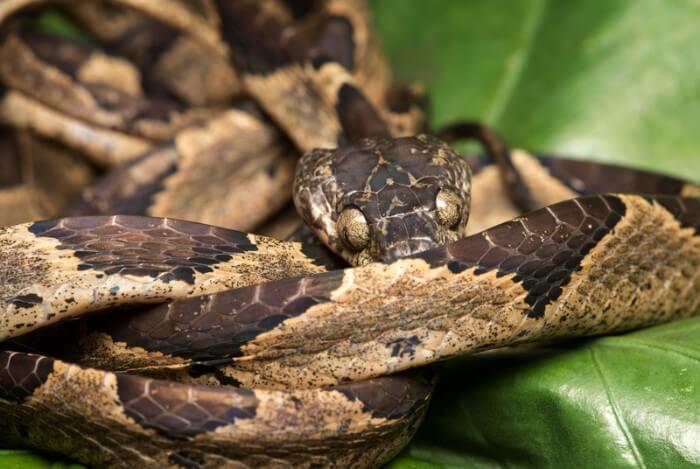
On the other hand, it is known that snakes will invade gardens and other properties in search of food.
Kittens are high-risk and the climbing abilities of cats won’t keep them safe either as most snakes can and do scale trees.
Nonvenomous snakes either swallow prey alive or kill by constriction.
Wikipedia
Also Read:
Do Owls Eat Cats?
Do Possums Eat Cats?
Do Bears Eat Cats?
How to Keep Snakes Away
Snakes use their heat-seeking senses to locate prey and also use their tongues to ‘smell’ potential sources of food.
- Don’t leave cat food or other pet food outside
- Use snake repellent
- Snakes don’t like vinegar, so splash some of it around
- As snakes can smell humans and usually shy away from them, sprinkle some human hair around your property
- Place ammonia saturated cloths in likely spots
The largest snake fossil ever discovered is called the Titanoboa it was 50 feet (15 meters) long.
livescience.com
Other Pets at Risk
Apart from cats, any other household pet will be considered an easy meal. Depending on their size, even dogs may become prey.
Pets left outside in cages won’t always be safe because snakes are able to slide through almost any small opening. Even amphibians and fish in your pond are at risk from snakes.
Take-away
Snakes do eat cats, but probably not any more frequently than any other pet.
As a cat owner that is worried for the safety of your cat you can contact local animal conservation organizations and find out what snakes inhabit your area and the steps you can take to safeguard your cat.
Sources:
- http://www.snake-removal.com/dangerouscatsdogs.html
- https://www.whatdosnakeseat.com/
- https://en.wikipedia.org/wiki/Snake
As an Amazon Associate I may earn a small fee from qualifying purchases at no extra cost to you. This helps us run the site, so thanks for your support!


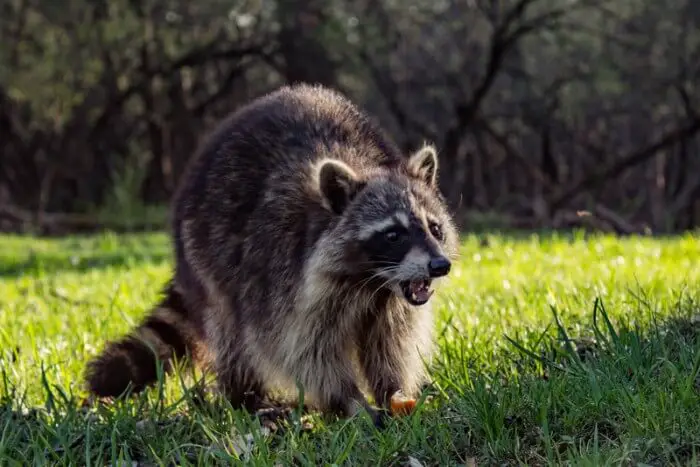



Leave a Comment